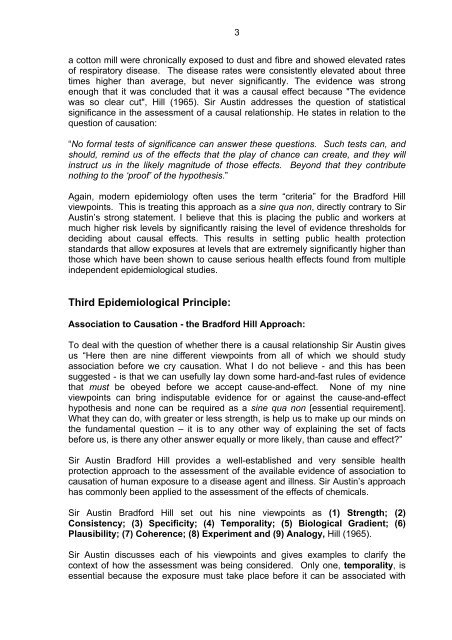Epidemiological principles for EMF and EMR studies - Lincoln ...
Epidemiological principles for EMF and EMR studies - Lincoln ...
Epidemiological principles for EMF and EMR studies - Lincoln ...
You also want an ePaper? Increase the reach of your titles
YUMPU automatically turns print PDFs into web optimized ePapers that Google loves.
3<br />
a cotton mill were chronically exposed to dust <strong>and</strong> fibre <strong>and</strong> showed elevated rates<br />
of respiratory disease. The disease rates were consistently elevated about three<br />
times higher than average, but never significantly. The evidence was strong<br />
enough that it was concluded that it was a causal effect because "The evidence<br />
was so clear cut", Hill (1965). Sir Austin addresses the question of statistical<br />
significance in the assessment of a causal relationship. He states in relation to the<br />
question of causation:<br />
“No <strong>for</strong>mal tests of significance can answer these questions. Such tests can, <strong>and</strong><br />
should, remind us of the effects that the play of chance can create, <strong>and</strong> they will<br />
instruct us in the likely magnitude of those effects. Beyond that they contribute<br />
nothing to the ‘proof’ of the hypothesis.”<br />
Again, modern epidemiology often uses the term “criteria” <strong>for</strong> the Brad<strong>for</strong>d Hill<br />
viewpoints. This is treating this approach as a sine qua non, directly contrary to Sir<br />
Austin’s strong statement. I believe that this is placing the public <strong>and</strong> workers at<br />
much higher risk levels by significantly raising the level of evidence thresholds <strong>for</strong><br />
deciding about causal effects. This results in setting public health protection<br />
st<strong>and</strong>ards that allow exposures at levels that are extremely significantly higher than<br />
those which have been shown to cause serious health effects found from multiple<br />
independent epidemiological <strong>studies</strong>.<br />
Third <strong>Epidemiological</strong> Principle:<br />
Association to Causation - the Brad<strong>for</strong>d Hill Approach:<br />
To deal with the question of whether there is a causal relationship Sir Austin gives<br />
us “Here then are nine different viewpoints from all of which we should study<br />
association be<strong>for</strong>e we cry causation. What I do not believe - <strong>and</strong> this has been<br />
suggested - is that we can usefully lay down some hard-<strong>and</strong>-fast rules of evidence<br />
that must be obeyed be<strong>for</strong>e we accept cause-<strong>and</strong>-effect. None of my nine<br />
viewpoints can bring indisputable evidence <strong>for</strong> or against the cause-<strong>and</strong>-effect<br />
hypothesis <strong>and</strong> none can be required as a sine qua non [essential requirement].<br />
What they can do, with greater or less strength, is help us to make up our minds on<br />
the fundamental question – it is to any other way of explaining the set of facts<br />
be<strong>for</strong>e us, is there any other answer equally or more likely, than cause <strong>and</strong> effect?”<br />
Sir Austin Brad<strong>for</strong>d Hill provides a well-established <strong>and</strong> very sensible health<br />
protection approach to the assessment of the available evidence of association to<br />
causation of human exposure to a disease agent <strong>and</strong> illness. Sir Austin’s approach<br />
has commonly been applied to the assessment of the effects of chemicals.<br />
Sir Austin Brad<strong>for</strong>d Hill set out his nine viewpoints as (1) Strength; (2)<br />
Consistency; (3) Specificity; (4) Temporality; (5) Biological Gradient; (6)<br />
Plausibility; (7) Coherence; (8) Experiment <strong>and</strong> (9) Analogy, Hill (1965).<br />
Sir Austin discusses each of his viewpoints <strong>and</strong> gives examples to clarify the<br />
context of how the assessment was being considered. Only one, temporality, is<br />
essential because the exposure must take place be<strong>for</strong>e it can be associated with
















